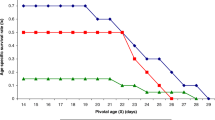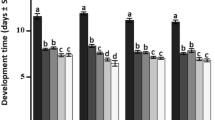Abstract
The response of an efficient egg-larval parasitoidChelonus blackburni Cameron to different ages and densities of potato tuber mothPhthorimaea operculella (Zeller) eggs was studied in a laboratory system. The parasitoid accepted 0–1, 1–2 and 2–3 day old eggs for parasitization. However, the eggs belonging to the first two age groups were significantly more acceptable when compared to the last age group. At low host density levels of 2 and 5 eggs per parasitoid, parasitoid emergence was zero. On increasing the host density, percent progeny production increased till a plateau was reached at a parasitoid-host ratio of 1∶50. This ratio thus proves to be ideal for obtaining maximum percent progeny production in the case of 0–1 and 1–2 day old eggs. Further increase in host density did not result in any significant increase in percent progeny production.
Résumé
On a étudié la réponse d'un parasitoïde oophage efficaceChelonus blackburni Cameron aux œufs de la Teigne de la pomme de terrePhthorimea operculella (Zeller) en fonction de leurs âges et de leurs densités au laboratoire. Le parasitoïde acceptait des œufs âgés de 0–1, 1–2 et 2–3 jours. Cependant, les œufs appartenant aux deux premiers groupes d'âge étaient significativement mieux acceptées que ceux du dernier groupe. Aux niveaux faibles de densité d'hôtes de 2 et 5 œufs par parasitoïde, la sortie du parasitoïde était nulle. En augmentant la densité d'hôtes, le pourcentage de production de la descendance augmentait jusqu'à atteindre un plateau se situant au niveau du rapport parasitoïde hôte de 1∶50. C'est le rapport idéal pour l'obtention du pourcentage maximum de descendants dans le cas d'œufs âgés de 0–1 et de 1–2 jours. Une augmentation supérieure de la densité d'hôtes n'entraînait pas un accroissement significatif du pourcentage de production de la descendance.
Similar content being viewed by others
References
Choudhary, R., Prasad, T. &Raj, B. T. — 1983. Field evaluation of some exotic parasitoids of potato tuber moth,Phthorimaea operculella (Zell.). —Ind. J. Entomol., 45, 504–506.
Fye, R. E. &Jackson, C. G. — 1973. Over-wintering ofChelonus blackburni in Arizona. —J. Econ. Entomol., 66, 807–808.
Jackson, C. G., Delph, J. S. &Neeman, E. G. — 1978. Development, longevity and fecundity ofChelonus blackburni [Hym.: Braconidae] as a parasite ofPectinophora gossypiella [Lepidoptera: Gelechiidae]. —Entomophaga, 23, 35–42.
Kumar, P. &Ballal, C. R. — 1990. Influence of laboratory hosts on the biological attributes ofChelonus blackburni [Hym.: Braconidae]. —Entomophaga, 35, 329–333.
Legner, E. F. &Medved, R. A. — 1981. Pink bollworm,Pectinophora gossypiella [Lepidoptera: Gelechiidae], suppression with gossyplure, a pyrethroid and parasite releases. —Can. Entomol., 113, 355–357.
Lewis, W. J. &Redlinger, L. M. — 1969. Suitability of the eggs of the almond moth,Cadra cautella of various ages for parasitism byTrichogramma evanescens. —Ann. Entomol. Soc. Am., 62, 1482–1484.
Paul, A. V. N., Parshad, B. &Kumar, P. — 1980. Age and density effect of the laboratory host,Corcyra cephalonica Stainton [Lep.: Pyralidae], on the egg larval parasitoidChelonus blackburni Cameron [Hym.: Braconidae]. —Z. Angew. Entomol., 90, 391–395.
Pawar, A. D., Prasad, J., Asre, R. &Raj Singh. — 1983. Introduction of exotic parasitoid,Chelonus blackburni Cameron in India for the control of cotton bollworms. —Ind. J. Entomol., 45, 436–439.
Prasad, J. Pawar, A. D. &Sharma, R. K. — 1982. Blocontrol trials with an exotic egg larval parasitoidChelonus blackburni Cameron onHeliothis armigera (Hübner) at Mundhal, Hissar, Haryana. —J. Adv. Zool., 3, 160–161.
Swamiappan, M. &Balasubramanian, M. — 1980. Studies on mass multiplication and potentiality ofChelonus blackburni Cam. a braconid parasite of cotton bollworms. —Entomon., 5, 73–75.
Author information
Authors and Affiliations
Rights and permissions
About this article
Cite this article
Ballal, C.R., Kumar, P. Response ofChelonus blackburni [Hym.: Braconidae] to different ages and densities of potato tuber moth eggs. Entomophaga 36, 513–518 (1991). https://doi.org/10.1007/BF02374433
Received:
Accepted:
Issue Date:
DOI: https://doi.org/10.1007/BF02374433




